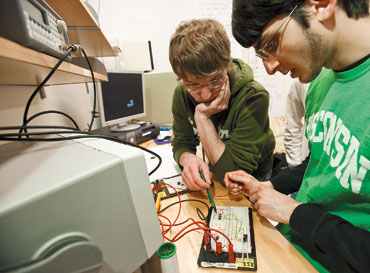Researcher uses GPS to find asthma causes
David Van Sickle is looking for a few pioneering asthmatics.
He wants to attach a GPS device to their inhalers before they boldly go out into a spring world filled with allergens.

Students Jeremy Schaefer (left) and Andrew Dias (right) work together in the Engineering Centers Building, on a project designed by postdoctoral fellow David Van Sickle to create a low-cost spirometer, a device used to measure lung function, that could be used in low income countries to diagnose and manage respiratory disease.
Photo: Bryce Richter
His goal is to map where and when environmental exposures trigger asthma symptoms, prompting them to puff on their “rescue” inhalers, which deliver the medicine that keeps them breathing. It’s one of two asthma-related projects in which Van Sickle, a Robert Wood Johnson Foundation Health and Society Scholar in the Department of Population Health Sciences, has worked with students in biomedical engineering.
It’s easy to predict problems when an asthmatic visits a “cat lady” or runs through a field of ragweed. But Van Sickle plans to use global positioning technology to find previously unknown causes of the lung disease and help doctors better monitor whether treatment is controlling symptoms and improving quality of life.
“Established risk factors for asthma do not explain its global prevalence patterns and time trends,” says Van Sickle. “Studies of epidemic asthma have demonstrated that understanding the locations where asthma exacerbations occur can help identify important new exposures.”

Van Sickle
Take, for example, an epidemic of severe asthma that struck Barcelona throughout the 1980s. On more than 20 days, emergency rooms were overwhelmed with people having severe, and sometimes fatal, asthma attacks.
“Barcelona put together a group of scientists to look at the meteorology, climatology, and levels of standard air pollutants and pollens in the city, but there wasn’t anything exceptional about those days,’’ he says.
Finally, they asked where the patients had been when they got sick: All reported that their symptoms started near the waterfront. Further investigation showed that the port had been unloading giant heaps of soybeans from container ships.
“The victims were exposed to massive clouds of soybean dust because the appropriate filters weren’t installed in harbor silos,’’ he says. “It took the group nearly eight years to prove, but it was the first time soybean dust had been shown to be a potent allergen.”
Before coming to Madison in 2006, Van Sickle was a disease detective in the Epidemic Intelligence Service at the Centers for Disease Control and Prevention (CDC) in Atlanta, a job that led him to investigate a number of outbreaks, including exposure to mold in post-Katrina New Orleans and chlorine gas in South Carolina.
In addition to tracing the causes of asthma, Van Sickle is also interested in better care for people who have the disease. Both interests have drawn him to work with the talented students enrolled in biomedical engineering classes. Past students designed early prototypes of the “asthmap” GPS device, which the CDC has now funded for use in the ongoing trial.
Current students enrolled in BME 201 are working on a low-cost spirometer, a device that measures lung function and is used in diagnosing asthma and other lung diseases.
Van Sickle, who has studied the increase of asthma in India, said commercially available spirometers are too expensive for most clinics there. The students are working on a design that could lower the cost from about $1,500 to $50. The project is set up as an “open source” endeavor on the Internet, allowing anyone access to their designs.
Raj B. Singh, chief respiratory physician at Apollo Hospital in Chennai, India, says that asthma is often misdiagnosed there due to a lack of proper equipment.
“Availability of a cheap, accurate and robust spirometer would certainly create more interest in performing lung function measurements, resulting in better care for people with chronic lung diseases in India,’’ says Singh, a member of the Global Initiative on Asthma (GINA) Executive Committee and founder of the Chest Foundation of India.
While the spirometers are likely to be of immediate benefit in the developing world, the GPS mapping may also someday help attack the spread of asthma.
Van Sickle says he can envision a time when GPS mapping of asthma outbreaks can allow researchers to “see” exactly what is making people sick.
“It will allow us to better target public-health interventions to the places and times when people are really suffering,” he says.
For more on the asthmap trial, call 261-1036 or e-mail asthmap@mailplus.wisc.edu. To learn more about the spirometer project, visit http://openspirometry.org.




